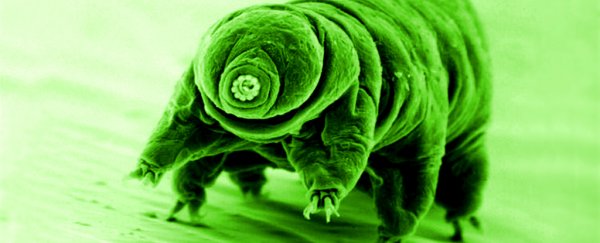Weird and wonderful, the microscopic tardigrades are sometimes colloquially known as 'water bears' and 'moss piglets'. In all fairness, though, no bear or piglet ever dreamt of doing the amazing things these uniquely gifted creatures are capable of.
Tardigrades are know for their incredible resilience, as they're able to survive all manner of extreme conditions.
When the going gets tough, they basically transform into glass for decades at a time, perhaps even centuries. They tolerate temperature extremes, and even the cold vacuum of space does not faze them.
While we're on that topic, tardigrades may also have just begun to colonise the Moon. It is an impressive achievement for something shorter than a millimetre.
Where do all these strange superpowers come from? The origin story of these aquatic organisms is a matter of ongoing scientific inquiry, but researchers think they've now at least solved the mystery of one of the water bear's weirdest abilities.
One of the things that makes tardigrades so seemingly indestructible is a built-in radiation shield of sorts.
A study in 2016 discovered that a protein unique to tardigrades called Dsup (damage suppressor) could suppress X-ray-induced DNA damage in human cells by approximately 40 percent.
"We were really surprised," one of the researchers, Takuma Hashimoto from the University of Tokyo, told AFP at the time.
"It is striking that a single gene is enough to improve the radiation tolerance of human cultured cells."
Such a degree of radiation tolerance is indeed striking, but how does it work? The answer remained unknown until just now – thanks to new findings made by scientists at the University of California, San Diego, who analysed Dsup to ascertain its molecular functions.
"We now have a molecular explanation for how Dsup protects cells from X-ray irradiation," says molecular biologist James Kadonaga.
"We see that it has two parts, one piece that binds to chromatin and the rest of it forming a kind of cloud that protects the DNA from hydroxyl radicals."
Hydroxyl radicals are particles that are generated in cells by ionising radiation. But tardigrades would also be exposed to these particles when the wet, mossy environments they dwell in become dry, triggering the water bears' dormant survival state called anhydrobiosis.
According to the researchers, the cloud-like Dsup formation that protects against DNA damage from hydroxyl radicals might not be an adaptation catered to protect against radiation, but simply one that evolved to protect against the hydroxyl radicals produced in dry environments.
If they're right about that, it confirms what the scientists behind the 2016 study also speculated.
"Tolerance against X-ray is thought to be a side-product of [the] animal's adaption to severe dehydration," lead researcher Takekazu Kunieda told Nature at the time.
Regardless of how and why the Dsup mechanism evolved, as we continue to improve our understanding of the tardigrade's tricks, scientists say we might one day be able to leverage their amazing abilities for ourselves.
"In theory, it seems possible that optimised versions of Dsup could be designed for the protection of DNA in many different types of cells," says Kadonaga.
"Dsup might thus be used in a range of applications, such as cell-based therapies and diagnostic kits in which increased cell survival is beneficial."
The findings are reported in eLife.
